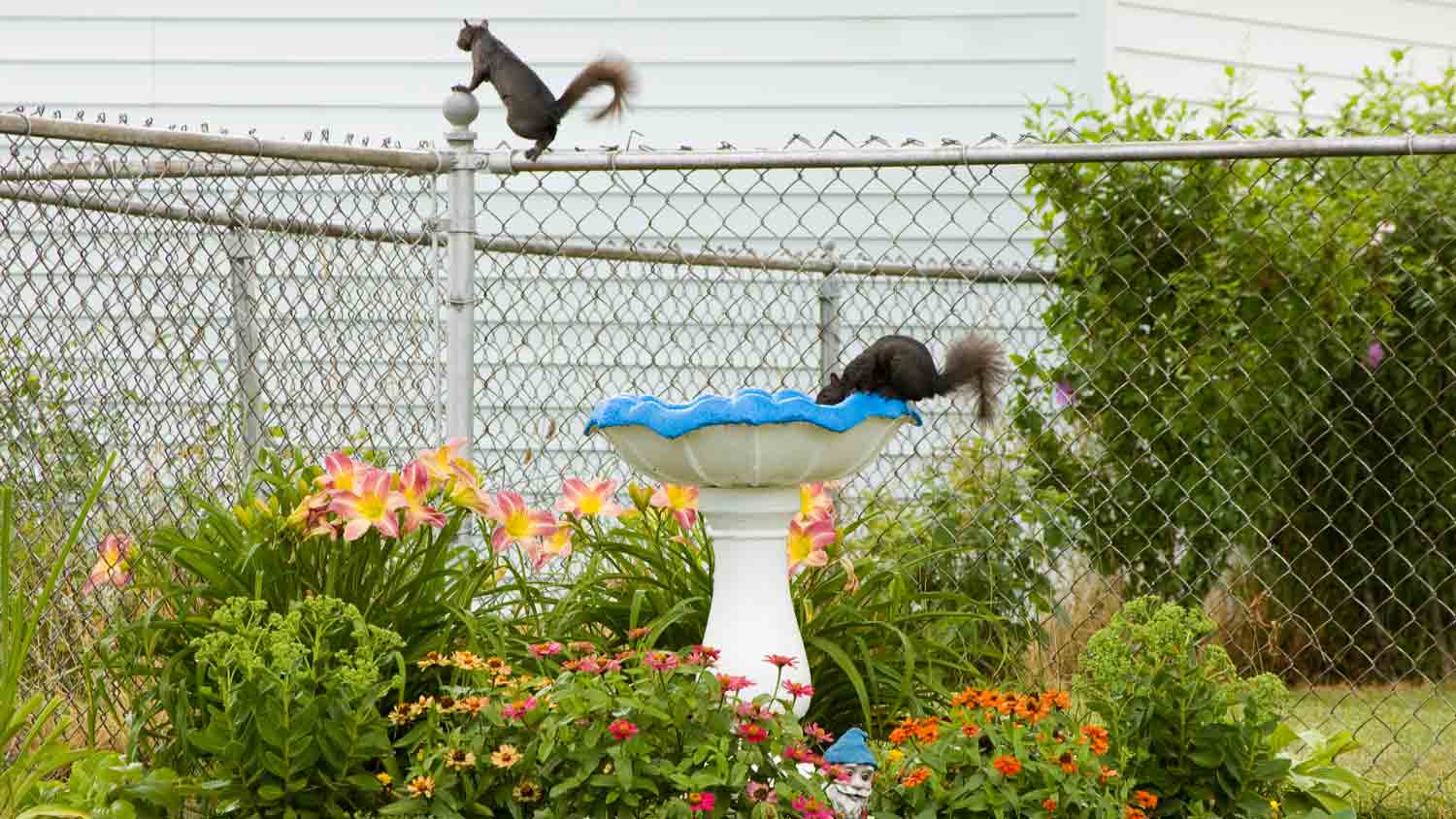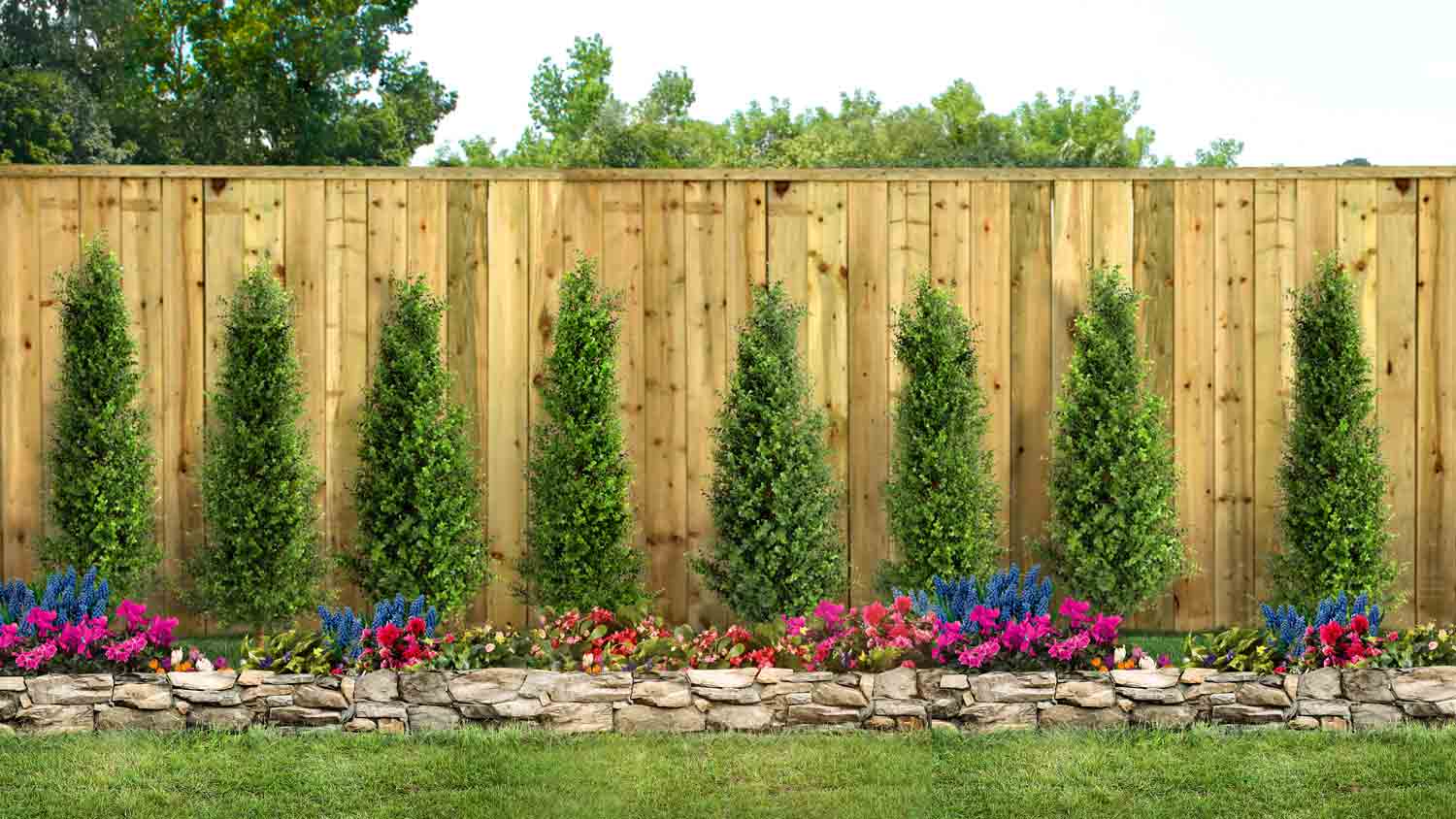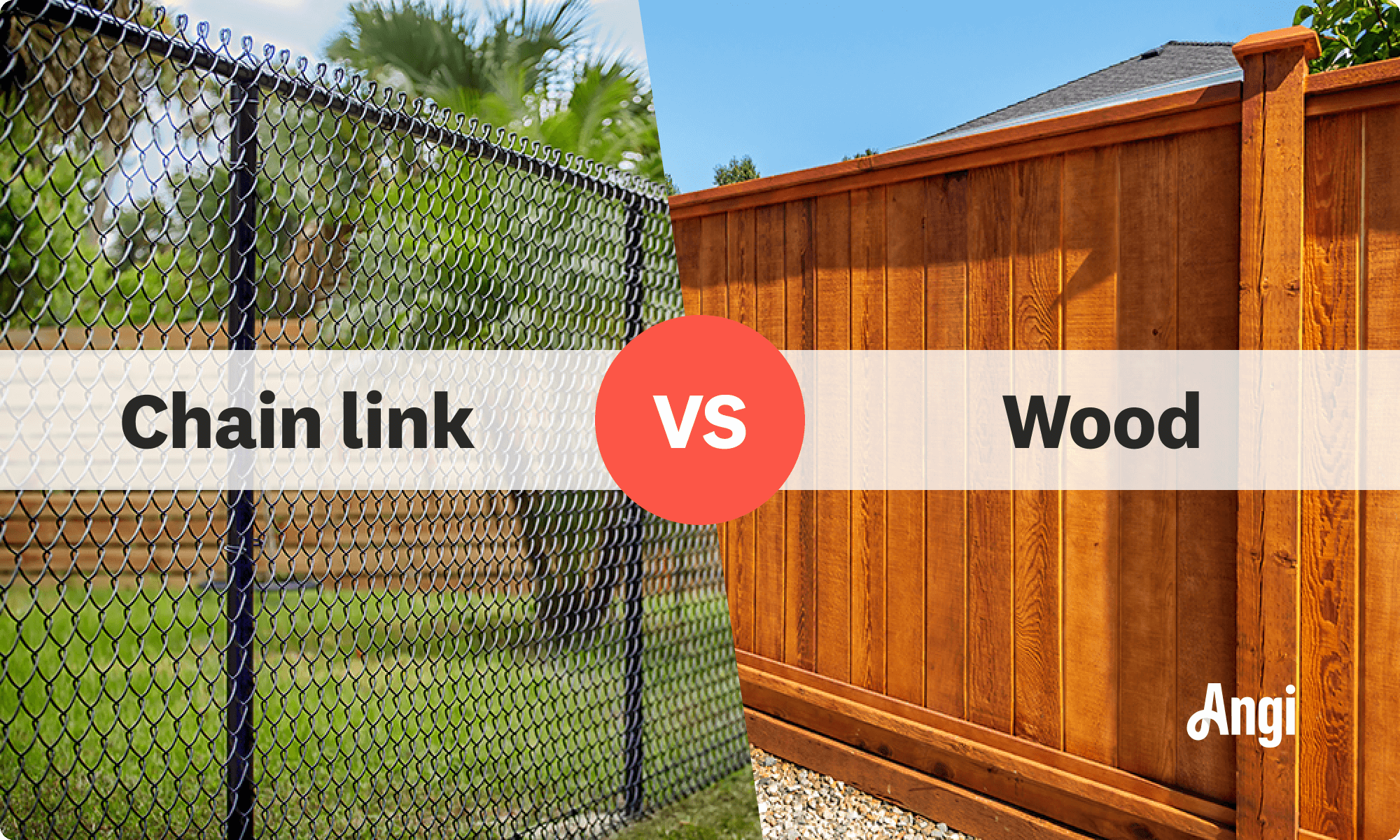
Explore the key factors that impact vinyl fence installation costs in Columbus, OH, including labor, materials, permits, layout, design, and yard conditions.
Pitting aesthetic appeal against durability


Wood is heralded for its aesthetic appeal and range of customization options.
While most durable, chain link has a reputation for looking too industrial.
Chain link is considered a more budget-friendly fencing option.
If you’re torn between a chain link fence vs. wood fence for your yard, you’re in the right place. While each fence option boasts appealing qualities, the choice relies on your specific needs and preferences. Whether long-term durability is paramount or you're looking for something with the most visual appeal, this guide will help you find the best option for your home.
Chain link fencing and wood fencing are two popular choices for homeowners to enclose their properties. Each varies greatly in appearance and function. Chain link fencing is made of interlinked metal wires, and is durable and cost-effective. Wood fencing offers a more traditional and aesthetically pleasing appearance. While chain link fencing excels in durability and visibility, wood fencing stands out for its natural appeal and privacy features.

Chain link fencing consists of interwoven metal wires to create a diamond pattern. Galvanized steel is commonly used to make this fencing and is known for being both durable and cost-effective. This fencing option provides a transparent barrier, making it a great choice for securing residential properties and defining boundaries. The material is low maintenance and can withstand harsh weather conditions, a win-win for anyone seeking a functional and reliable fence.
| Pros | Cons |
|---|---|
| Affordable | Lacks aesthetic appeal |
| Durable | Prone to corrosion |
| Low-maintenance | Challenging to install |
| Offers clear visibility | Lacks privacy |
Best for:
Homes with high-security needs
Pet owners who require a secure and contained space
Defining clear, visible property boundaries
Temporary security needs, such as during construction
Chain link fencing stands out from other fencing options due to its affordability, making it a budget-friendly solution for property owners in search of reliable security. Its durability is unmatched, with the material renowned for its resilience and ability to withstand diverse weather conditions. Chain link is a worthwhile investment that offers continuous protection over time.
The transparent nature of chain link fencing enhances visibility, allowing homeowners to feel secure without sacrificing their view. Its low maintenance requirements also contribute to its appeal, as chain link fencing doesn't need painting and is resistant to rot and pests, reducing the need for frequent upkeep.
The biggest drawback of chain link fencing is its lack of beauty. For many homeowners, the utilitarian look isn't as desirable as more decorative fencing options. While the open design of chain link fencing provides visibility, it also makes it less private. Another drawback is the potential for increased noise transmission because the open structure doesn't offer much in the way of sound insulation.
It’ll be a labor-intensive process for your local fence installation pro to construct a chain link fence. This is especially true if constructing the fence in large areas or on uneven terrain. Despite being galvanized to resist corrosion, chain link fencing can show signs of rust over time in certain conditions. While this usually happens over a long period, it could occur more quickly depending on the location and weather conditions. That means you'd have to do some maintenance.

Wood fencing is a classic and versatile fencing option known for its natural aesthetics and ability to complement various architectural styles. Most often comprised of individual boards or panels attached to horizontal rails and vertical posts, wood fencing provides privacy and acts as an effective safety barrier. The wide range of wood types, styles, and finishes available allows for customization to match the specific preferences and design requirements. While it does offer a traditional and warm appearance, wood fencing also requires regular maintenance, such as staining or sealing, to preserve its durability and resist rot and decay.
| Pros | Cons |
|---|---|
| Aesthetically appealing | Requires maintenance |
| Private | High cost |
| Versatile customization | Less durable |
| Can be sustainable | Limited lifespan |
Best for:
Homeowners looking for a classic fencing option with beauty and warmth
Areas where privacy is a great concern
Individuals who prioritize environmentally friendly building materials
Designs requiring specific customization
Wood fencing boasts natural beauty and a warm, classic appearance that can enhance the overall charm of a property. The material comes in numerous styles, designs, and finishes, allowing for customization to meet specific aesthetic and functional preferences. This allows the product to blend seamlessly with various architectural styles.
Beyond its visual appeal, wood fencing excels in providing privacy, creating secluded areas for homeowners to enjoy their outdoor spaces without intrusion. For the environmentally-conscious homeowner, certain types of wood fences are a renewable resource and responsibly sourced materials contribute to its sustainability.
Despite being renowned for its visual appeal, the use of wood can pose quite a few challenges, with notable maintenance requirements to preserve its longevity and appearance. Wood is not as durable as other materials and may deteriorate over time, especially in harsh weather conditions. The fences require regular upkeep, such as staining, sealing, and repairs to protect against weather, decay, and insect damage, which can add to the overall cost.
Because it lacks some durability, wood has a limited lifespan. Without proper care, it may require replacement in the future. How long does a wood fence last? On average, most wood fences have a lifespan of 15 years, with some lasting as long as 20 years. However, this is less than other materials, such as vinyl or aluminum. Maintenance is key when it comes to increasing its longevity.
Installing a wood fence can also be time-consuming because you must place individual posts and attach multiple boards or panels.

The charm of wood fencing lies in its natural aesthetic, which is widely considered more visually appealing than chain link fencing. Wood has an organic beauty with varied grain patterns and rich tones that provide outdoor spaces with timeless and classic elegance. Unlike the plain and utilitarian appearance of chain link, wood fencing offers warmth and craftsmanship.
Wooden fences provide more options for customization than chain link fencing, giving property owners the flexibility to design a fence that suits their unique aesthetic preferences and practical needs. The natural qualities of wood enable homeowners to create diverse styles, finishes, and configurations, from traditional picket fences to decorative designs that complement the architecture. Chain link fences are limited in terms of design and may not integrate seamlessly with various landscaping themes or architectural styles.
The durability of chain link fencing is often attributed to its interwoven metal wires, which are commonly constructed from galvanized steel. The material is inherently resistant to a range of hazards, such as corrosion, pests, and harsh weather. Chain link fencing can endure heavy rain, snowfall, and intense sunlight without the common problems of rotting, warping, or insect damage that afflict wood fencing. Aside from being an excellent option for areas with extreme weather conditions or high-security needs, its low maintenance requirements and cost-effectiveness make it a smart and long-lasting choice.
Chain link is considered a more budget-friendly fencing option. The average chain link fence cost ranges between $1,300 and $3,540, while a wood fence cost averages between $1,790 and $4,560. Another crucial cost factor to consider is the maintenance required to keep a wood fence in its best shape, which is less of a concern for chain link fences.
While chain link and wood fencing can both pose challenges with installation, chain link is considered easier than wood. The components of chain link fencing, such as metal posts and interwoven wires, are lightweight and modular, making them easier to handle and maneuver during installation.
Unlike wood fencing, which often requires precise measurements, cutting, and alignment of individual panels or pickets, chain link fencing can be more forgiving in terms of alignment due to its flexible and adaptable design. Additionally, the construction of chain link fences involves fewer steps, reducing the complexity of the installation compared to wood fencing.
For homeowners looking for DIY solutions, chain link may be easier for the average DIY homeowner, whereas wood fence installation may require advanced knowledge.
Chain link fencing is more manageable to fix than wood fencing. When a part of chain link fencing is damaged, removing and replacing individual sections of the chain link fabric or repairing damaged posts is straightforward. The modular composition of chain link components allows for targeted repairs without extensive disassembly or reconstruction.
Wood fencing, however, may require more complicated repairs, particularly when individual panels or pickets require replacement. Wood can also be vulnerable to rot, warping, or insect damage, and addressing these problems requires more intricate repair work, including cutting, fitting, and securing new wood pieces.
Compared to wood fencing, chain link fences have the advantage of requiring minimal upkeep due to the metal components' natural resistance to issues such as rot, decay, and pests. Any routine maintenance that chain link fencing might require would only involve occasional cleaning to remove dirt or debris, and repairs are straightforward and involve simply replacing individual components.
Wood fencing requires more regular maintenance to preserve its appearance and structural integrity. This maintenance can include staining, sealing, and addressing potential issues like rot or insect damage. As a result, maintaining wood fencing is more labor-intensive and time-consuming compared to the low-maintenance nature of chain link fencing.
Chain link fencing can last between 25 to 30 years on average, but a well-maintained fence can extend that lifespan. Wood, on the other hand, only lasts about 15 years and, even if properly maintained and repaired, may only last 20 years.
Opting for wood fencing obtained from sustainably managed forests can be viewed as a more ecologically responsible choice compared to chain link fencing. The renewable nature of timber, the primary material used for wood fencing, lends itself to environmentally sound harvesting techniques. Such methods of responsible forestry encompass planting new trees and ensuring long-term forest health.
As a biodegradable material, wood contributes to less environmental impact at the end of its life cycle than non-biodegradable materials such as metal. Choosing certified, sustainably sourced wood and utilizing eco-friendly treatment methods further increases the sustainability of wood fencing, making it a viable option for anyone with ecological concerns.
From average costs to expert advice, get all the answers you need to get your job done.

Explore the key factors that impact vinyl fence installation costs in Columbus, OH, including labor, materials, permits, layout, design, and yard conditions.

Black fencing adds some elegance to your property while maintaining security. Use this black chain-link fence cost guide to get an estimate for your fencing.

A fence can be a beautiful and functional addition to your property. Learn all the factors that determine your fence installation costs in Columbus, OH.

If you share a fence with your neighbor, you may wonder who owns it or has to maintain it. Read on to learn who is responsible for a shared fence.

Looking for a way to increase privacy at home without taking on extra chores? Learn about the best low-maintenance fence options.

Determining whether to repair or replace fence installations can be a difficult choice. Learn more about what factors can help you decide which way to go.